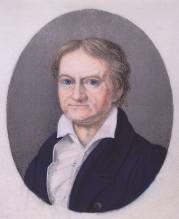Draftsman, printmaker, publisher

Born in 1811 in Ścięgny, as a son of a baker. After his father death in 1827, he moved to Kowary. There he was looked after by his 20 years older half-brother Carl Gottfried. He saw his extraordinary abilities in art, he sent him to Friedrich August Tittel (1782–1836) who was well known painter and copperplate artist in the area, founder of first publishing house in Kowary. He studied there for 5 years – to 1832. After he finished studing , Knippler stayed there and worked as draftsman and engraver. Collaboration between master and student was so good that they became friend. We can assume it based on the fact that Tittel assigned him as a executor, and asked him to look after his sons; after Tittel death in 1836, Knippel administrated publishing house on his behalf.
In 1839 Knippel married wealthy divorcee Augusta Heidrich née Tschirnhaus. Change of material status enabled him to help his career. In 1840 he bought publishing house from Tittels sons, and started to run it with Carl Julius Rieden (1802–1858).
It is Rieden who is considered to be the greatest artist in the group of artists from Kowary. He was also without doubt the humblest one. How it can be described differently if his own name only appears on the paintings after he became associate with Knippel. From archives we can learn about his earlier works for Tittel and Mattis. Born in 1802 in Kowary. After learning from Tittel from 1817 to 1822 he worked at lithographic publishing house of Mattis, where he was “Main Draftsman” and lithographer, he was also responsible for correspondence with clients and paymasters. Being very satisfied with his work in the mid 30s, Mattis planned to make him a manager of the publishing house and printing house “Mattis et Comp” in Kamienna Góra. Rieden was supposed to be associate with Mattis’ son. Despite being granted a license, venture didn’t kicked off. During that time terrible thing happened to the Rieden; in 1835 his wife Amalia Henrietta passed away, being 33 years old, one year later his child also passed away. He remarried at the late 40s, with his second wife he had 3 daughters. He passed away in 1858, being 56 years old.
Rieden & Knippel Company ( That was the order that they put their names on the paintings) continued Tittels publishing intensions. Of course there were some changes.The main change was the technique in which print was created. Etching used by Tittlel was replaced by lithography. That method was easier and faster, thanks to it was possible to print much more copies without reduction of the prints quality, it also created a possibility of making potential corrections of it,it was already used by Mattis’ publishing house in Kowary. To acquire new clients they expended theirs theme list of paintings. In addition to panoramic paintings, mountain views, cities, palaces and Castles paintings, artists also started to present industrial landscapes like: ironworks, factories foundries that were built at Silesia. They also presented new mills from area, for example glass factory “Józefina” in Szklarska Poręba !. Collection that contained 80 lithographs of that groundbreaking theme is one of the greatest in theirs ouerve. Orders form Upper Silesian industrial magnates helped with artistic quality of prints. The more original ones are night time views of mills that were created with rather simple way. Black paintings were pressed to the dark-blue paper covered in print, only the reflections were painted with red tint. Time period when artists worked together is the most intensive and creative.
After Rieden death in 1858, Knippel was administrating publishing house alone. He published large amount of not only new works but also the older ones. Widoki ze Śnieżki na cztery strony świata created in between 1881 – 1882,presented landscape with topographic accurancy, was one of the last lithograph created by Knippel.
Cost of lithographs was rather high: big ones (size about 30x40 cm), hand painted costed 7-9 thalers (monthly payment of a miner), smaller ones costed 4- 6, black and white, 1-3.To reach the larger group of customers, Knippel released motives from bigger signed graphics in form similar to postcards, often in particular black and white were without signature.
In 70s and 80s of XIX century photography became rival of prints. We can clearly see a change in publishing market, postcard with high circulation became more popular. At that time Knippel tried to expanse his business by designing patterns for rugs for local manufactory.
After E. W. Knippel death at the age of 89, publishing house was shortly administered by his son Ludwig. In 1908 Lithographer W. Müller became owner of it. He also acquired rights to use old name. In the jubilee publishing in 1913 about celebration of 400 years of the city (Fest-Schrift zum 400 jährigen Stadtjubiläum Schmiedebergs 1513–1913), there was an advertisement of E. W. Knippels’ publishing house where he not only encourages to buy lithographs from 1840-1870 and postcards, but also to visit prints that are available for purchase.